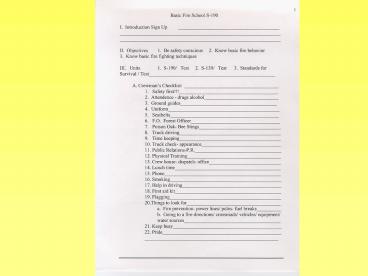Introduction to Wildland Fire Behavior - PowerPoint PPT Presentation
1 / 36
Title:
Introduction to Wildland Fire Behavior
Description:
Shrub. Timber litter. Logging Slash. Fuel Moisture: ... grass, leaves, shrubs. Heavy fuels: Limbs, logs, stumps. Fuel Loading: ... – PowerPoint PPT presentation
Number of Views:203
Avg rating:3.0/5.0
Title: Introduction to Wildland Fire Behavior
1
(No Transcript)
2
S-190Introduction to Wildland Fire Behavior
3
Why we feel fire behavior training is critical
4
COURSE OBJECTIVES
- Identify and discuss the three sides of the
fire triangle.
- Identify the environmental factors of wildland
fire behavior that affect the start and spread of
wildland fire. - Recognize situations that indicate problem or
extreme wildland fire behavior.
5
Unit 1 Objectives
1. Describe the fire triangle 2. Identify three
methods of heat transfer 3. List the three
principle environmental elements affecting
wildland fire behavior. 4. List three fuel
factors that affect the start and spread of
wildland fire. 5. List 3 weather factors that
affect fuel moisture 6. Describe how wind affects
wildland fire spread 7. Describe the effect of
slope on wildland fire spread 8. List 4
topographic factors that affect wildland fire
behavior 9. Describe the dangerous conditions
that can develop in a box canyon steep narrow
canyon
6
Fire Triangle
Heat
Oxygen
Fuel
7
Heat Transfer
Radiation
Convection
Conduction
8
Three Principal Environmental Elements Affecting
Wildland Fire Behavior
Fuels
Weather
Topography
9
Fuels
- Fuel Type
- Fuel Moisture
- Size and Shape
- Fuel Loading
- Horizontal Continuity
- Vertical Arrangement
10
- Fuel Types
- Grass
- Shrub
- Timber litter
- Logging Slash
11
Fuel Moisture
- The amount of water in a fuel expressed as a
percentage of the oven-dry weight of that fuel
12
Categories of Fuels Light fuels grass, leaves,
shrubs Heavy fuels Limbs, logs, stumps
13
Fuel Loading
- The quantity of fuels in an area.
- Generally expressed in Tons per Acre.
14
Horizontal Continuity Uniform vs Patchy
Vertical Arrangement - Ground - Surface -
Aerial
15
Ground Fuels
- All combustible materials lying beneath the
surface including deep duff, roots, rotten buried
logs, and other organic material.
16
Surface Fuels
- All materials lying on or immediately above the
ground including needles or leaves, grass, downed
logs, stumps, large limbs and low shrubs.
17
Aerial Fuels
- All green and dead materials located in the
upper forest canopy including tree branches and
crowns, snags, moss, and high shrubs.
18
Size-Up
Point of Origin
Locate and protect the point of origin.
19
Size-Up
Size
Estimate the fire size.
20
Size-Up
Fire Behavior
Smoldering
21
Size-Up
Fire Behavior
Creeping
22
Size-Up
Fire Behavior
Running
23
Size-Up
Fire Behavior
Crowning
24
Size-Up
Fire Behavior
Crowning
...or Torching
25
Size-Up
Aspect
Which aspect?
Dry south west?
Greener north east?
26
Weather
- Temperature
- Wind - Increases supply of oxygen
- Drives convective heat into adjacent fuels.
- Influences spread direction and spotting.
- Carries moist air away replacing it with drier
air. - Dries Fuels.
- Raises fuel moisture if the air contains
moisture.
27
Weather
- Temperature
- Relative Humidity - As RH increases, fuel
moisture increases - Precipitation - Increases fuel moisture
28
Topography
- Aspect - direction a slope faces
- Slope - Steepness
- Position of Fire - Top, middle, or bottom of
slope - Shape of Country - Narrow canyons box canyons
- Elevation - Relates to curing of fuels,
precipitation, length of fire season, etc.
29
Aspect
30
Steep Slopes Cause Rapid Fire Spread
31
Position of Fire on Slope
32
Box Canyon Chimney Effect
33
Radiant Heat AcrossNarrow Canyon
34
Spotting Across Narrow Canyon
35
Mountains Cause Channeling of Wind
36
Elevation































